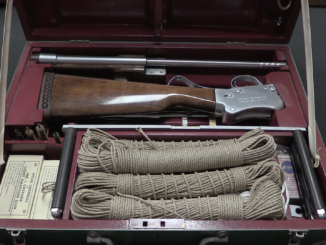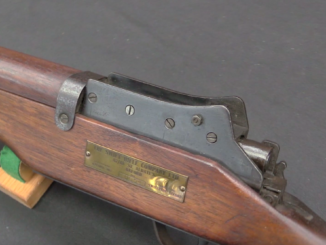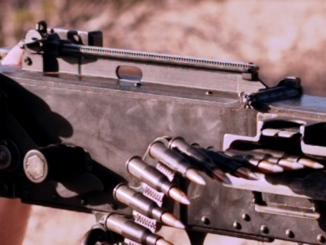The Sten Mk5 (sometimes written Sten MkV) was really the Cadillac of the Sten series. It was designed in 1943, and featured a full wooden buttstock patterned after the No4 Enfield rifle, as well as a front sight abductor bayonet lugs for the Enfield. It has a wooden pistol grip as well (and early production examples also had a wooden vertical front grip). It was mechanically the same as the earlier Stens, simply with the fire control group moved forward to fit the pistol grip.
The Mk5 was not quite as insanely cheap and fast to make as the MkII and MkIII, but by the time it went into production British arms supply had largely caught up to demand, and they could afford to be a bit less economical. The Mk5 was really much better handling than earlier models, and was well liked, seeing combat as early as the invasion of Normandy in June 1944. In total, 527,428 of them were produced and they remained in service until the adoption of the L2 Sterling submachine gun in 1957 (and they were not completely phased out until at least the late 1960s).
Many thanks to the Royal Armouries for allowing me to film and disassemble this submachine guns! The NFC collection there – perhaps the best military small arms collection in Western Europe – is available by appointment to researchers:
https://royalarmouries.org/research/national-firearms-centre/
You can browse the various Armouries collections online here:
https://royalarmouries.org/collection/




If I understand correctly the Mk5 butt stock could be attached to a Mk2 – I wonder if that was a common thing?
Mk5 was basically a cosmetically-redesigned Mk2.
They moved the trigger group forward 2.4in to make room for the wood pistol grip, and added the Rifle No.4 front sight assembly to the barrel so they could stick the No.4 spike bayonet on it.
The stock attachment was never changed from the Mk2. They just bolted a Rifle No.4 buttstock to the attaching iron instead of the single steel strut or tubular frame stock of the Mk2.
The one thing the Mk5 had over the Mk2 was that it could be fired minus the stock, due to having its own separate pistol grip. Other than that, it was no particular improvement.
clear ether
eon
Actually the Mk. V had a significant functional improvement over the Mk. II, which was the addition of a safety lock on the bolt. This was a much-needed change since accidental discharge was one of the most common faults of the Mk. II and sometimes caused fatalities.
All versions of the Sten had exactly the same safety; a notch in the bolt handle slot the handle locked up into to keep the bolt from moving.
So I’m not seeing your point, here.
clear ether
eon
The additional safety feature was a push through for the cocking handle to lock the bolt when it was forward with a loaded magazine in place. Hence you didn’t run the risk of accidental discharge/runaway gun if it was dropped on its butt or even jolted. It looks like this was also retrofitted to earlier marks of Sten, you can see the hole on the left hand side.
As Paul M mentioned, the Mk. V had a push-in bolt handle which locked the bolt in the closed position (much like the MP 40). Earlier Sten models didn’t have this and there was nothing to stop the bolt from firing off a round if it was dropped. In 1944/45 these safety locks were retrofitted to earlier Mk. II and Mk. III guns but it was a feature introduced by the Mk. V.
I’ve always wandered: how the original Sten gun would accommodate the NATO 5.56 mm bullet – of course, with the barrel and other relevant parts altered accordingly?!
I’m trying to wrap my head around the idea of a blowback 5.56mm NATO, and I’m unable to even comprehend the weight of the requisite bolt and recoil spring combination…
I really don’t think the result would be at all usable, to be quite honest. I suspect it’d be on the scale of a .50 cal anti-material rifle, in terms of weight and size…
“(…)wrap my head(…)”
Then look at already existing blow-back 5,56×45 mm weapon known as Fusil automático Bogotá https://guns.fandom.com/wiki/FaB_556
I think a much better alternative would be the 7.62 x 25 Tokarev paired with the double feed PPS43 magazine. This would have given almost M1 carbine like longer range performance. Ironically these weapons actually existed in China, with re-worked Mk 2 Stens originally provided by Canada during WW2 being used.
“(…)almost M1 carbine like longer range performance(…)”
There was attempt at blow-back cheap 7,62×33 mm weapon known as T-29
https://www.reddit.com/r/ForgottenWeapons/comments/14m8wti/t29_the_30_carbine_grease_gun/
it did not get beyond prototype stage, but I do not know if that was due to technical shortcomings or simply lack of need for such weapon (with M1 Carbines being made in millions, literally).
STEN spawned intermediate cartridge weapon, though it was Kurzpatrone, not 5,56 x 45 mm NATO. It is known as Wimmersperg Spz-l see 1st image from top https://imfdb.org/wiki/Wimmersperg_Spz
Gino, stop wandering crazy fantasies. Tell pizzaiolo to tone down the funny green leafy stuff hes been puttin’ on your pizza instead of rucola. You can not fit jet fighter engine inside Fiat Topolino, capisce?
@Daweo
I find it frightening and mildly offending that oneoff junk captured from south american gangs started having its dedicated wikipedia style pages! 🙂
“(…)can not fit jet fighter engine inside Fiat Topolino(…)”
However one managed to fit piston aviation engine inside Goggomobil https://www.youtube.com/watch?v=f2V7B7-gdRA
Hahaha, great find! I stand corrected.
“(…)adoption of the L2 Sterling submachine gun in 1957(…)”
According to https://guns.fandom.com/wiki/Sterling_submachine_gun …Patchett Mk.II was officially adopted as the L2A1 on the 18th of September 1953… so what actually happened w.r.t. L2 in 1957?
If I remember rightly, the Sterling only came in after the US forced 7.62 NATO down the throats of the British, which is what necessitated the replacement of the MkV and the take-up of the Sterling/Patchett.
Before that, the EM-2 was supposed to be filling the role of the SMG.
The last Mk5 Sten I handled in the 50’s (during a TA recruitment drive) had a bolt safety that the bolt handle coud be pushed through to keep the bolt from moving.
GJ
You are right, the Mk V was the first Sten that, as it came from the factory, had the “Mk. IV cocking handle” to lock the bolt in the forward(!) position.
But it could be added also to the earlier Stens: “suitable for any mark of Sten”.
Above quotes from: Small Arms Training, Volume I, Pamphlet No. 21, The Machine Carbine, 15 Jun 1944, p. 27-28.
Accidents happened, due to the bolt in the forward position gliding backwards enough to feed and fire a round when the gun (rear end) hit something hard enough. This was also a problem of the German MP38 and MP40. The latter received a modified cocking handle that allowed to lock the bold forward (Rücklaufsperre).
For clarification: The original safety slot only locked the bolt in the rearward (gun cocked) position. This was bad in the field, because it left the gun open for the entry of dirt.
Main problem with Sten’s still remained, wonky magazines. You can polish a gun as much as you want, if magazine has issues reliability will still suffer.
Hence the Sterling probably; great mag, and good gun overall… But stand out mag.
According to https://smallarmsreview.com/aftermarket-sten-magazines/
…primary problem with original Sten magazines is the spreading of the feed lips, which changes the feed angle and leads to failure to feed stoppages(…)If you leave original Sten magazines fully loaded over an extended period of time, you will probably encounter functioning problems(…)Seven of the Keep Shooting and four of the TAPCO magazines were loaded and tested twice. They were fired in two different Sten variants and a Sterling submachine gun. There were a few stoppages encountered in firing 700-plus rounds, but none could be directly attributed to a magazine malfunction….
So apparently it is possible to made more reliable magazine which could be used in unaltered STEN machine carbine.
Since magwell is removable, one could theoretically (with modded bolt), refurbish sten to sterling magazines.
If fcg is moved, does that mean that bolt cocked is not in the same distance from magazine, as in mk3 or mk2 ?